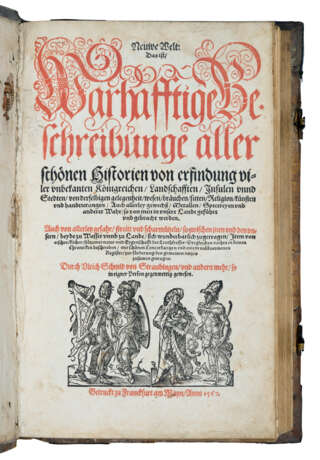Neuwe Welt
16.10.2025 10:00UTC +01:00
Classic
To bid, go to the website
CHRISTIE'S| Auctioneer | CHRISTIE'S |
|---|---|
| Event location | United Kingdom, London |
| Buyer Premium | see on Website% |
ID 1471975
Lot 52 | Neuwe Welt
Estimate value
40000USD $ 40 000 – 60 000
First edition of one of the rarest German collections of voyages, which includes the first printing of Schmidel’s important travels to present-day Argentina and southern Brazil under Don Pedro de Mendoza. It also includes accounts of several Portuguese voyages to India and an early printing of Hans Staden’s captivity narrative among the Tupi. Goldwurm’s work is a catalogue of miracles.
A Bavarian mercenary, Schmidel set sail in August 1535 as a member of the expedition led by Don Pedro de Mendoza to colonize the lands of the Rio de la Plata. He would spend 18 years in the region. Sebastian Cabot had returned from there in 1530 after abandoning his mission to cross the Pacific when he heard rumors of great mineral wealth. His reports of abundant silver on the shores of Rio de la Plata inspired Mendoza's huge expedition. Penrose called it, "[t]he greatest expedition to be sent out from Spain to America since Columbus' Second Voyage. ... Ulrich Schmidt—or Schmidel, to give his name the Spanish rendering—served throughout this enterprise and enriched posterity by an excellent account of the adventures of the settlers" (p. 123).
The second South American narrative in the collection is that of Hans Staden. Staden arrived in Brazil in 1547 with the entourage of Adelantado Sanabria. He lived in the province of Sanabria and also in Sao Vicente, but then suffered the misfortune of being captured by Tupi Indians. He was rescued after nine months by a French vessel, and upon returning to Europe, an account of his sensational experiences was rushed to the press in 1557.Staden was an "ethnographer nuanced and meticulous enough to engineer first the postponement and then the cancellation of his slaughter and consumption. [His] purported position of dependency on native social and religious understandings makes him a unique witness to the early encounter between European adventurers and indigenous inhabitants in Brazil" (Johnson, review of Hans Staden's True History: An Account of Cannibal Captivity in Brazil, 2011).
In 1567 Sigmund Feyerabend published these works in two issues: 1) as a continuation of Sebastian Franck's Weltbuch in which this volume was entitled Ander theil dieses Weltbuchs von Schiffahrten; 2) separately, as here. In addition to the different titles, different woodblocks are used to illustrate the title-pages. In this separate issue, there is an attempt at ethnographic illustration—drawing attention to the exotic content of this volume as a separate work. Priority (if it exists) has not been determined. Both issues are extremely rare. Not in Borba; European Americana 567/50; JCB I, 237; Palau 304834; Sabin 77678; VD16 G2603 (Goldwurm).
Two works bound together, folio (306 x 192mm). Both titles printed in red and black and with woodcut vignettes (some pale dampstain in upper margin encroaching to text at ends, a little staining to a5-6, intermittent short marginal wormhole near bottom of gutter, occasional toning, several lines censored on 1.D6v in Schmidel’s account). Contemporary blind-stamped pigskin over wooden boards, decorated panels incorporating roll-tooled portraits of Melanchthon, Luther and Calvin and emblems of Fides-Spes-Caritas-Fortitudo, original brass corner-pieces with bosses, clasps and catches, title in ink on fore-edge (some soiling, two repaired cracks to lower cover, some scrapes to upper pastedown exposing supports). Provenance: David Parsons, 1939-2014 (his sale, Sotheby’s New York, 11 December 2007, lot 87) – Antonio Bonchristiano (bookplate).
| Place of origin: | Germany |
|---|---|
| Auction house category: | Printed books |
| Place of origin: | Germany |
|---|---|
| Auction house category: | Printed books |
| Address of auction |
CHRISTIE'S 8 King Street, St. James's SW1Y 6QT London United Kingdom | |
|---|---|---|
| Preview |
| |
| Phone | +44 (0)20 7839 9060 | |
| Buyer Premium | see on Website | |
| Conditions of purchase | Conditions of purchase |


